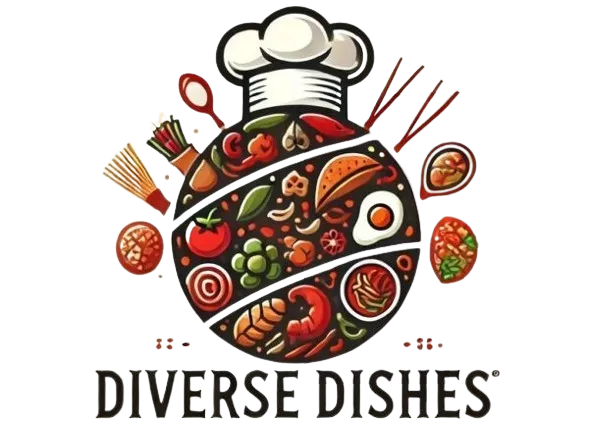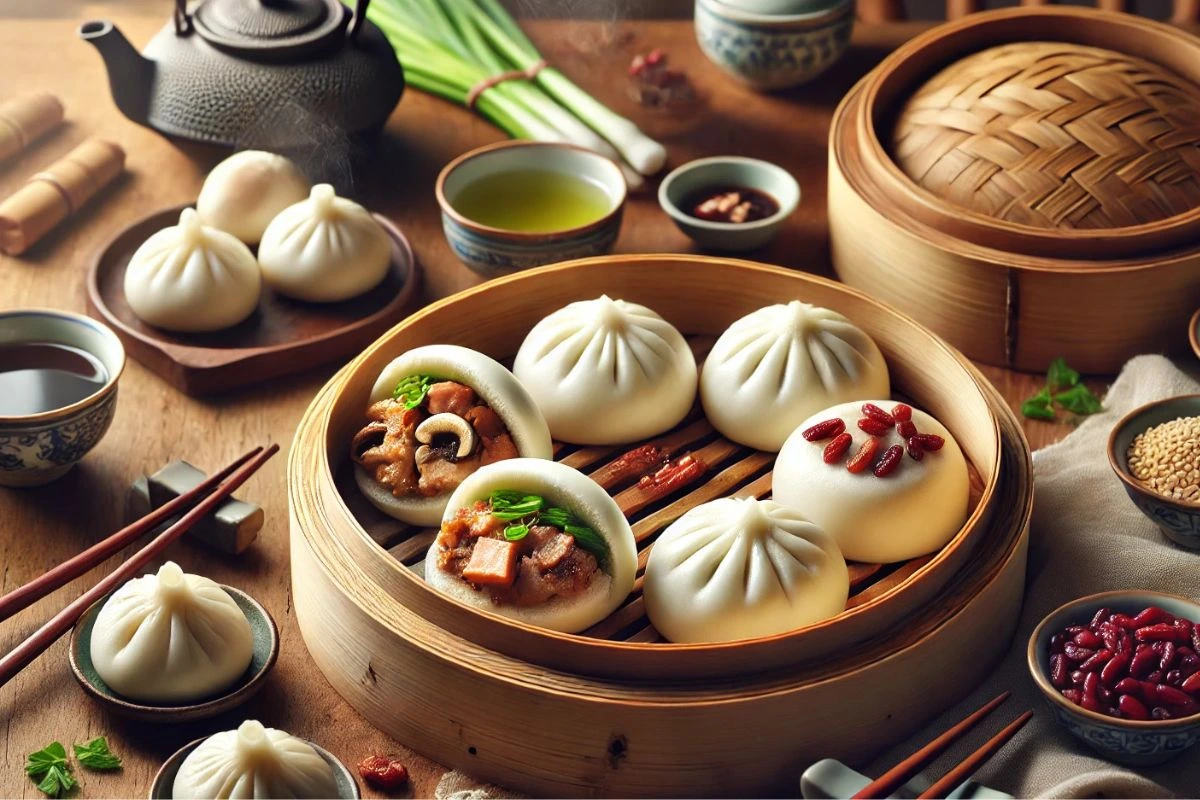How to Make Delicious and Nutritious Meals with Fu Bao
Introduction:
Fu Bao, a soft, chewy steamed bun originating from East Asia, is gaining popularity for its versatility in recipes and health benefits. Traditionally filled with sweet or savory ingredients, Fu Bao offers endless possibilities to enhance your meals. This article will explore creative methods of utilizing Fu Bao in recipes, from traditional methods to unique twists, and how this delightful ingredient can add flavor, nutrition, and an exotic touch to your dishes.
Table of Contents
What is Fu Bao or ?
Fu Bao, also known as the “lucky bun” or “blessing bun,” has its roots in Chinese cuisine and is traditionally enjoyed during celebrations as a symbol of good fortune and prosperity. These filled buns often feature sweet pastes, meats, or vegetables, then are steamed to perfection, resulting in a soft, fluffy texture and mild taste that pairs well with a variety of fillings.
Health Benefits
Fu Bao are generally made with wheat flour, water, and yeast, making them a low-fat option with complex carbohydrates. Here are some health benefits of incorporating lucky buns into your diet:
- Low in Fat: Traditional bun is steamed, not fried, which keeps it low in unhealthy fats.
- Rich in Fiber: Whole wheat flour can increase the fiber content, aiding in digestion and maintaining energy levels.
- Versatile and Nutrient-Dense: Fillings can be customized to include nutrient-rich vegetables, lean meats, and plant-based proteins.
How to Use Fu Bao in Recipes: Traditional and Creative Ideas
Fu Bao can be a meal centerpiece, a snack, or even a dessert. Here are some creative methods to incorporate Fu Bao into your meals:
1. Classic Pork or Chicken

A staple in many Asian cuisines, pork or chicken-filled Fu Bao is a savory delight. Here’s how to make it:
Ingredients:
- 1 lb ground pork or chicken
- 2 tbsp soy sauce
- 1 tbsp oyster sauce
- 1 tsp sesame oil
- 1 tbsp minced garlic
- 1 tbsp minced ginger
- Salt and pepper to taste
Instructions:
- In a bowl, combine the ground meat with soy sauce, oyster sauce, sesame oil, garlic, and ginger.
- Season with salt and pepper, and mix thoroughly.
- Fill each bun with a spoonful of the mixture.
- Steam for 15-20 minutes or until the meat is fully cooked.
Serve these savory buns as appetizers or a light meal with dipping sauces like hoisin or chili paste for an added kick.
2. Vegetarian with Mushrooms and Tofu Recipe
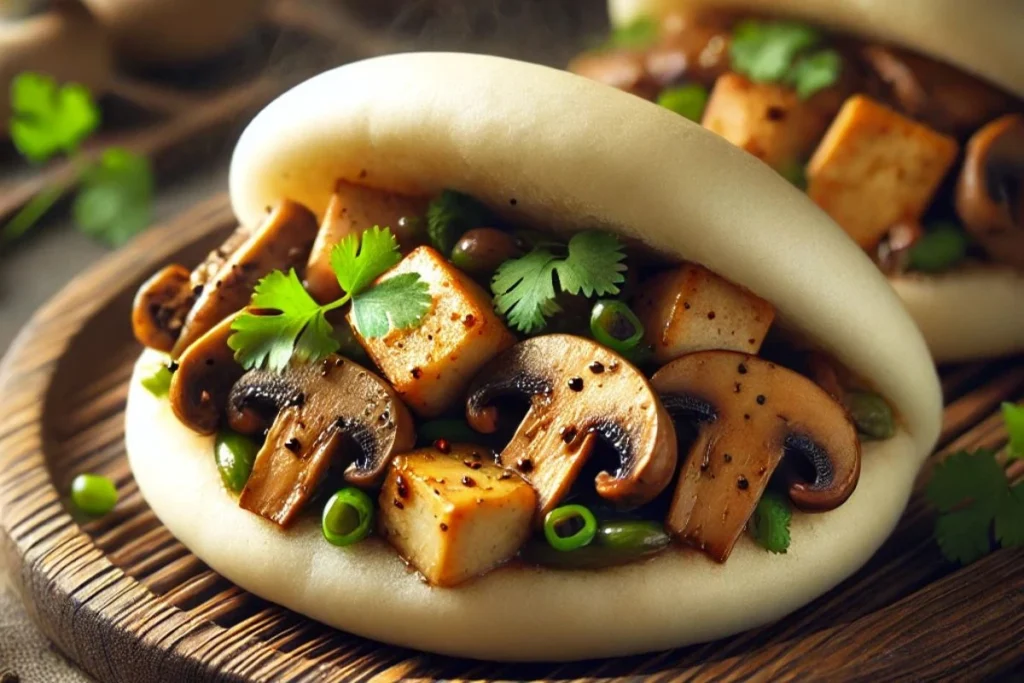
This vegetarian option is flavorful and packed with protein from tofu.
Ingredients:
- 1 cup diced tofu
- 1 cup diced mushrooms
- 1 tbsp soy sauce
- 1 tbsp hoisin sauce
- 1 tsp minced garlic
- 1 tbsp scallions
Instructions:
- Sauté the tofu and mushrooms with soy sauce, hoisin sauce, and garlic until browned and fragrant.
- Add the scallions for a touch of freshness.
- Fill the Fu Bao buns with the mushroom and tofu mixture.
- Steam for 15 minutes.
This vegetarian Fu Bao option is perfect for a healthy, plant-based snack or light meal.
3. Sweet Red Bean Paste Fu Bao Recipe
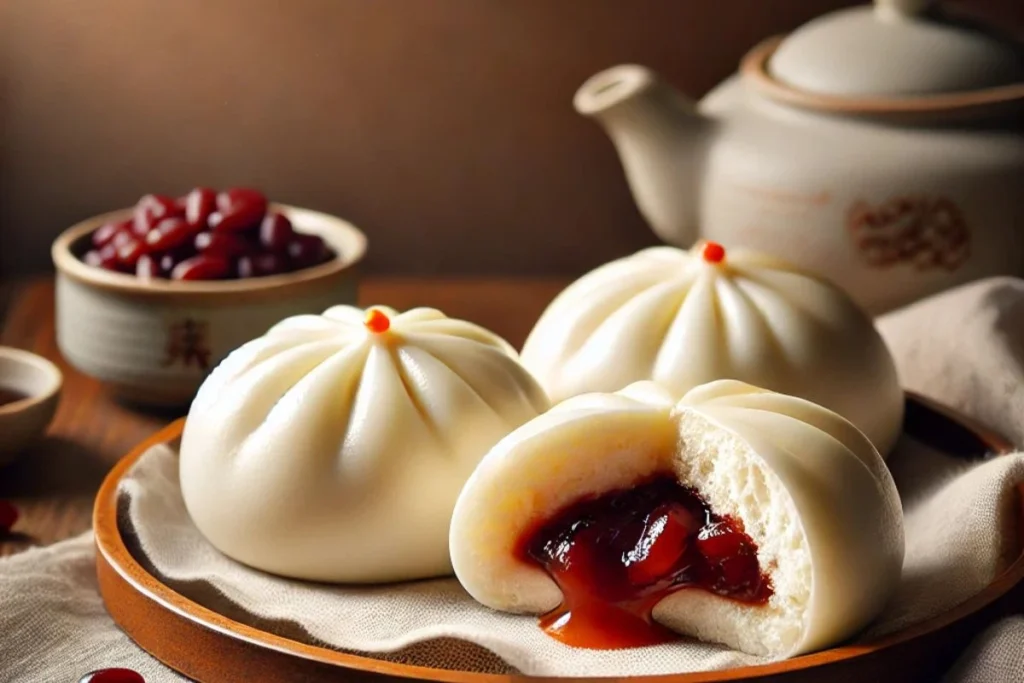
For those with a sweet tooth, red bean paste Fu Bao is a classic dessert option.
Ingredients:
- 1 cup sweet red bean paste (available at Asian grocery stores)
- Sugar (optional, to taste)
Instructions:
- Place a spoonful of red bean paste in each Fu Bao.
- Steam for 12-15 minutes until the buns are soft and fluffy.
This sweet version of Fu Bao is perfect as a dessert or a mid-day snack with tea.
4. Breakfast Fu Bao with Scrambled Eggs and Bacon recipe
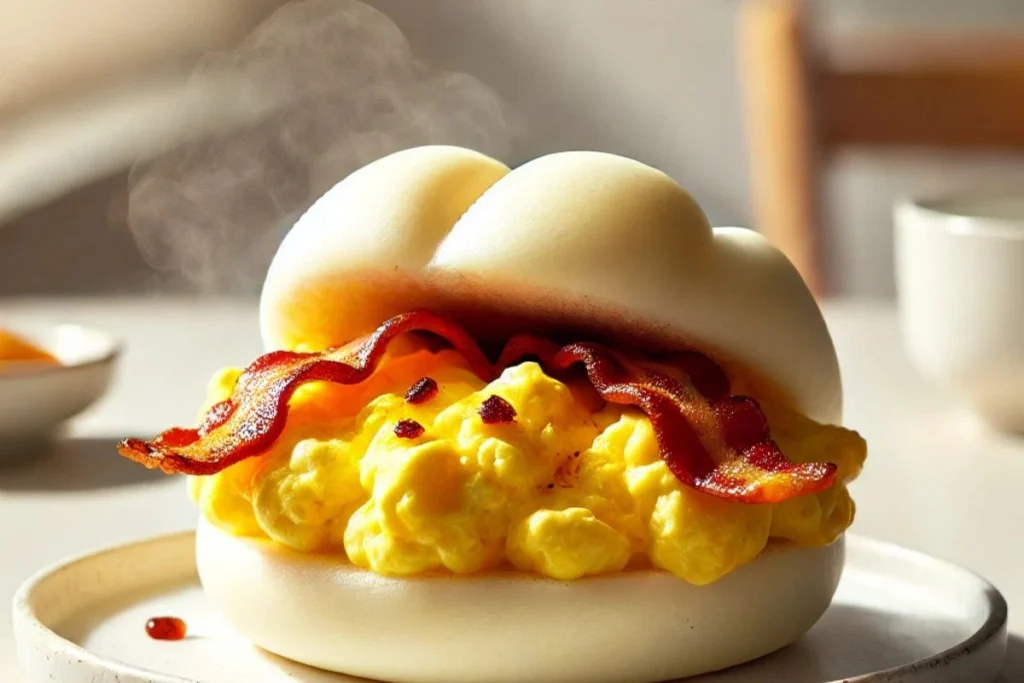
Give your breakfast a twist by using Fu Bao instead of regular bread.
Ingredients:
- 2 scrambled eggs
- 2 slices of cooked bacon, crumbled
- Salt and pepper to taste
Instructions:
- Scramble the eggs with salt and pepper to taste.
- Add crumbled bacon to the eggs.
- Fill each Fu Bao with a portion of the egg and bacon mixture.
- Steam for a few minutes to warm it up.
This Fu Bao version is great for a protein-packed, flavorful breakfast that’s easy to prepare.
5. Spicy Fu Bao with Kimchi and Ground Beef recipe
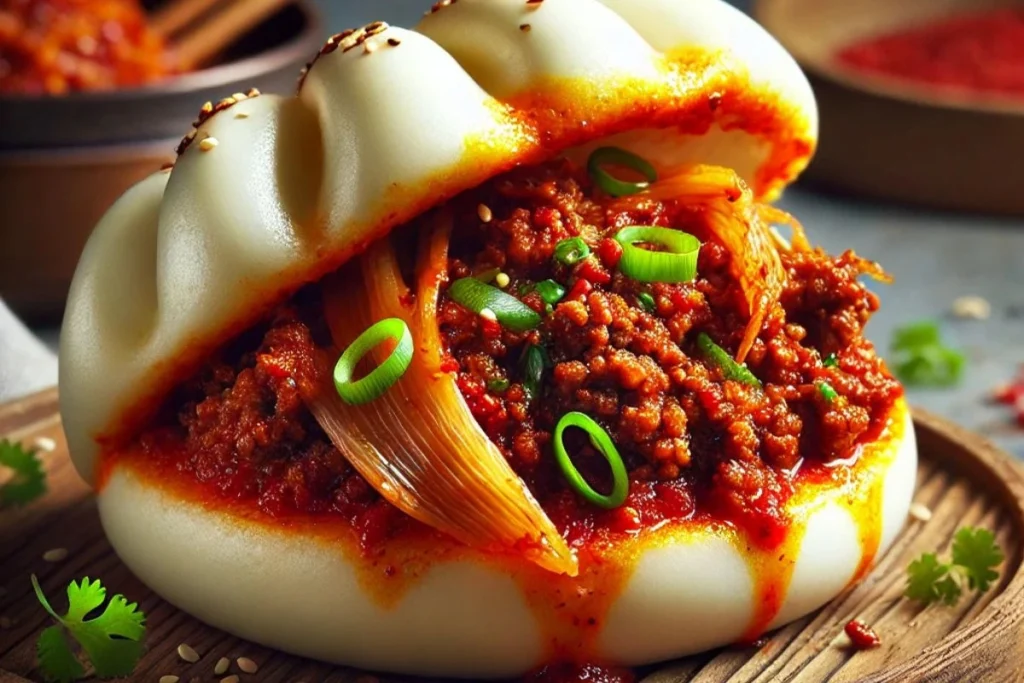
Add a Korean twist to your Fu Bao with a spicy kimchi filling.
Ingredients:
- 1 cup ground beef
- ½ cup chopped kimchi
- 1 tbsp gochujang (Korean chili paste)
- 1 tsp sesame oil
Instructions:
- Brown the ground beef with kimchi and gochujang until fully cooked.
- Add sesame oil for flavor and mix well.
- Place a spoonful of the mixture into each Fu Bao.
- Steam for 12-15 minutes.
This spicy Fu Bao pairs well with a cooling cucumber salad for a balanced meal.
6. Dessert Fu Bao with Custard Filling recipe

Create a sweet, custard-filled bun for dessert.
Ingredients:
- 1 cup prepared custard (store-bought or homemade)
- 1 tbsp vanilla extract
Instructions:
- Fill each bun with a spoonful of custard.
- Steam for about 10 minutes.
The custard bun is creamy, soft, and perfect for satisfying dessert cravings.
Nutritional Value : A Closer Look
The nutritional profile of Fu Bao varies based on the ingredients used in the dough and fillings. Here’s a general breakdown of the key nutrients you can expect in a typical Fu Bao:
- Carbohydrates: The primary ingredient, flour, provides complex carbohydrates that offer sustained energy. Each bun generally contains around 20-30 grams of carbs, depending on its size and filling.
- Protein: Buns filled with lean proteins, such as chicken, pork, or tofu, can provide 5-10 grams of protein per bun. This makes them a suitable option for a balanced snack or light meal.
- Fats: These buns are traditionally steamed, keeping their fat content relatively low, especially if filled with vegetables or lean proteins. Fat content will vary with the addition of oils, meats, or cheese but typically remains under 5 grams per bun.
- Fiber: Buns made with whole-wheat flour can increase the fiber content, aiding digestion and keeping you full longer. Fiber content is generally around 1-3 grams per bun, higher if vegetables are part of the filling.
- Vitamins and Minerals: Buns filled with vegetables offer essential vitamins like vitamin C, A, and potassium. Meat-filled buns provide iron and B vitamins, while tofu-based buns add calcium and magnesium.
Customizing Fu Bao for Specific Dietary Needs
Fu Bao can easily be modified to accommodate various dietary requirements, making it an inclusive option for a range of dietary needs. Here are some ways to adjust Fu Bao for specific diets:
1. Gluten-Free Fu Bao
For those with gluten intolerance, buns can be made with gluten-free flours like rice flour or a gluten-free all-purpose blend. Keep in mind that the texture may vary slightly, so experimenting with flour ratios is key to achieving the desired consistency.
2. Low-Carb or Keto-Friendly Fu Bao
For those on a low-carb or keto diet, replacing wheat flour with almond or coconut flour may lower the carbohydrate content. Additionally, fillings can be adjusted to include high-fat ingredients like cheese or avocado.
3. Vegan Fu Bao
A vegan bun can be easily created by choosing plant-based fillings like tofu, mushrooms, and vegetables. Sweet options with red bean paste or coconut milk-based custards also work well for vegan diets.
4. High-Protein Fu Bao
To make a protein-rich bun, consider using fillings like grilled chicken, shrimp, or ground turkey. You could also try adding protein powder to the dough or opting for higher-protein flours like chickpea flour.
5. Whole-Wheat or High-Fiber Fu Bao
Swap regular flour with whole-wheat or oat flour for added fiber. Whole grains bring additional health benefits, such as sustained energy release and better digestion support.
How Fu Bao Fits into a Balanced Diet
Buns, with their versatile fillings and nutrient-dense ingredients, can fit well into a balanced diet. By carefully selecting ingredients, you can adjust the nutritional profile to meet your health goals, whether that’s increasing protein, reducing fat, or adding more fiber. Here’s how buns can work as part of a balanced eating plan:
As a Snack: Smaller, vegetable-filled buns make excellent mid-day snacks, providing energy and fiber without high calories or fats.
As a Meal: Pairing two or three buns with a side salad or soup creates a balanced, satisfying meal. Opt for lean proteins like chicken or tofu, and add vegetables to enhance nutrition.
Post-Workout Option: Protein-packed buns with fillings like chicken, pork, or eggs can make a quick, nutritious post-workout snack, helping with muscle recovery and refueling.
Healthy Dessert Alternative: Sweet buns, such as those with red bean paste or low-sugar custard, offer a healthier dessert choice than traditional high-sugar treats.
Fu Bao Around the World: Regional Variations and Inspiration
While steamed buns originated in East Asia, similar variations can be found around the world, showcasing how cultures have embraced the concept of filled, steamed buns.
- Japanese Nikuman
In Japan, these buns are known as Nikuman. They are typically filled with pork, vegetables, and sometimes seafood, offering a savory taste with Japanese seasonings. Nikuman is often enjoyed as street food, especially during winter, as a warm and filling snack.
- Korean Hoppang
Hoppang is the Korean version of steamed buns and is usually overflowing with sweet red bean filling or a flavorful combination of meat and vegetables. Hoppang is sold at street stalls and convenience stores and is particularly popular in colder months.
- Philippine Siopao
In the Philippines, Siopao is a common steamed bun that is filled with different components, including pork asado, chicken, and even salted egg. Siopao is often eaten as a snack or a meal, paired with a savory dipping sauce.
- Hawaiian Manapua
Manapua is Hawaii’s take on steamed buns, a soft, steamed bun typically filled with pork or char siu. This dish showcases the influence of Chinese cuisine on Hawaiian culture and is a beloved part of Hawaiian cuisine.
Final Thoughts: Embracing the Versatility
Steamed buns are more than just a snack; they’re a canvas for culinary creativity and cultural exploration. Whether you’re preparing them for traditional reasons or as part of a new recipe fusion, steamed buns can add depth, taste, and international flair to your kitchen. With endless filling options and combinations, these buns bring together tradition, health, and innovation in a single, delicious bite.
By incorporating steamed buns into your meal planning, experimenting with fillings, and adjusting ingredients to meet dietary needs, you can enjoy this traditional treat in new and exciting ways. So gather your ingredients, unleash your creativity, and let steamed buns become a staple in your kitchen.
Disclaimers:
“The health benefits described are based on traditional recipes and ingredients. Nutritional values may vary depending on preparation methods and specific fillings.”
